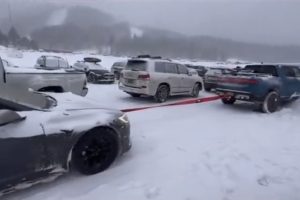- 🔭 Luminar Technologies noted that Tesla was its largest customer for LIDAR products in Q1 2024.
- 👁️ Tesla has used LIDAR units to validate vision data on its test vehicles for Full Self-Driving (FSD) training.
- 🚫 Elon Musk stated that Tesla no longer needs LIDAR even for collecting ground truth data.
- ⚡ Musk reiterated his stance that LIDAR is not necessary for self-driving vehicles.
- 🤖 Tesla is focusing heavily on FSD, with plans to unveil its dedicated “Cybercab” robotaxi on August 8, 2024.
- 🚀 Musk believes going “balls to the wall for autonomy” is a “blindingly obvious move” for Tesla.
In a move that underscores Tesla’s unwavering commitment to its vision-based approach to autonomous driving, Elon Musk recently declared that the electric vehicle giant no longer needs LIDAR (Light Detection and Ranging) sensors, even for collecting ground truth data. This bold statement comes on the heels of a revelation by Luminar Technologies, a leading LIDAR sensor manufacturer, which named Tesla as its largest customer for LIDAR products in the first quarter of 2024.
The Role of LIDAR in Tesla’s FSD Journey
LIDAR has played a crucial role in Tesla’s pursuit of Full Self-Driving (FSD) capabilities. The company has traditionally employed these sensors on its test vehicles to validate and fine-tune the vision data collected by the vehicles’ cameras. This practice has been a source of scrutiny and criticism from skeptics, who viewed it as a contradiction to Musk’s previous statements dismissing LIDAR as a “fool’s errand” for self-driving cars.
However, Musk’s recent comments shed light on Tesla’s evolving strategy, indicating that the company has reached a point where it no longer requires LIDAR for ground truthing purposes. This development signifies a significant milestone in Tesla’s journey towards achieving true autonomy through its vision-based approach.
The Vision-Based Approach: Pushing the Boundaries of Perception
Tesla’s vision-based approach to autonomous driving relies heavily on the company’s cutting-edge neural networks and computer vision algorithms. By training these systems on vast amounts of real-world data collected from its fleet of vehicles, Tesla aims to create a comprehensive understanding of the driving environment that surpasses the capabilities of traditional sensor-based systems.
Musk’s dismissal of LIDAR’s necessity for ground truth data collection suggests that Tesla’s vision algorithms have reached a level of maturity and accuracy that renders LIDAR redundant for this specific task. This achievement not only represents a technological breakthrough but also reinforces Tesla’s commitment to its vision-based strategy, which Musk believes is the most scalable and cost-effective approach to achieving full autonomy.
The Road to Robotaxis: Unveiling the “Cybercab”
Tesla’s unwavering focus on FSD is further evidenced by the company’s plans to unveil its dedicated “Cybercab” robotaxi on August 8, 2024. This highly anticipated event promises to showcase Tesla’s latest advancements in autonomous driving technology, potentially revolutionizing the concept of urban mobility.
The Cybercab, a specialized vehicle designed specifically for ride-sharing and autonomous transportation services, will serve as a testament to Tesla’s vision for a future where self-driving vehicles seamlessly integrate into our cities, providing efficient, eco-friendly, and cost-effective transportation solutions.
A “Blindingly Obvious Move”: Musk’s Unwavering Commitment
Elon Musk’s unwavering commitment to pursuing autonomy is rooted in his belief that it is a “blindingly obvious move” for Tesla. In his own words, “going balls to the wall for autonomy” is a strategic imperative, as “everything else is like variations on a horse carriage.”
This bold statement reflects Musk’s conviction that autonomous driving technology represents a paradigm shift in transportation, one that will fundamentally reshape the way we perceive and interact with mobility. By pushing the boundaries of what is possible with vision-based systems, Tesla aims to position itself at the forefront of this revolution, driving innovation and setting new industry standards.
As Tesla continues to refine its vision algorithms and neural networks, the company’s ability to achieve true autonomy without relying on LIDAR or other traditional sensors becomes increasingly plausible. This groundbreaking approach not only challenges conventional wisdom but also opens up new avenues for innovation and disruption in the automotive industry.
With the Cybercab’s unveiling on the horizon and Musk’s unwavering commitment to autonomy, Tesla is poised to usher in a new era of transportation, one where self-driving vehicles seamlessly navigate our cities, offering unprecedented levels of safety, efficiency, and convenience. The future of mobility is rapidly unfolding, and Tesla’s vision-based approach promises to be a driving force in shaping this transformative journey.





